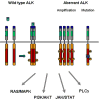Emerging importance of ALK in neuroblastoma
- PMID: 21945349
- PMCID: PMC3242371
- DOI: 10.1016/j.semcancer.2011.09.005
Emerging importance of ALK in neuroblastoma
Abstract
Since the original descriptions of gain-of function mutations in anaplastic lymphoma kinase (ALK), interest in the role of this receptor tyrosine kinase in neuroblastoma development and as a potential therapeutic target has escalated. As a group, the activating point mutations in full-length ALK, found in approximately 8% of all neuroblastoma tumors, are distributed evenly across different clinical stages. However, the most frequent somatic mutation, F1174L, is associated with amplification of the MYCN oncogene. This combination of features appears to confer a worse prognosis than MYCN amplification alone, suggesting a cooperative effect on neuroblastoma formation by these two proteins. Indeed, F1174L has shown more potent transforming activity in vivo than the second most common activating mutation, R1275Q, and is responsible for innate and acquired resistance to crizotinib, a clinically relevant ALK inhibitor that will soon be commercially available. These advances cast ALK as a bona fide oncoprotein in neuroblastoma and emphasize the need to understand ALK-mediated signaling in this tumor. This review addresses many of the current issues surrounding the role of ALK in normal development and neuroblastoma pathogenesis, and discusses the prospects for clinically effective targeted treatments based on ALK inhibition.
Copyright © 2011 Elsevier Ltd. All rights reserved.
Conflict of interest statement
Figures


Similar articles
-
Molecular rationale for the use of PI3K/AKT/mTOR pathway inhibitors in combination with crizotinib in ALK-mutated neuroblastoma.Oncotarget. 2014 Sep 30;5(18):8737-49. doi: 10.18632/oncotarget.2372. Oncotarget. 2014. PMID: 25228590 Free PMC article.
-
The ALK(F1174L) mutation potentiates the oncogenic activity of MYCN in neuroblastoma.Cancer Cell. 2012 Jul 10;22(1):117-30. doi: 10.1016/j.ccr.2012.06.001. Cancer Cell. 2012. PMID: 22789543 Free PMC article.
-
The R1275Q neuroblastoma mutant and certain ATP-competitive inhibitors stabilize alternative activation loop conformations of anaplastic lymphoma kinase.J Biol Chem. 2012 Oct 26;287(44):37447-57. doi: 10.1074/jbc.M112.391425. Epub 2012 Aug 29. J Biol Chem. 2012. PMID: 22932897 Free PMC article.
-
New strategies in neuroblastoma: Therapeutic targeting of MYCN and ALK.Clin Cancer Res. 2013 Nov 1;19(21):5814-21. doi: 10.1158/1078-0432.CCR-13-0680. Epub 2013 Aug 21. Clin Cancer Res. 2013. PMID: 23965898 Free PMC article. Review.
-
Oncogenic mutations of ALK in neuroblastoma.Cancer Sci. 2011 Feb;102(2):302-8. doi: 10.1111/j.1349-7006.2010.01825.x. Cancer Sci. 2011. PMID: 21205076 Free PMC article. Review.
Cited by
-
ALK and MYCN: when two oncogenes are better than one.Cancer Cell. 2012 Mar 20;21(3):325-6. doi: 10.1016/j.ccr.2012.03.004. Cancer Cell. 2012. PMID: 22439928 Free PMC article.
-
Olfactory neuroblastoma mimics molecular heterogeneity and lineage trajectories of small-cell lung cancer.Cancer Cell. 2024 Jun 10;42(6):1086-1105.e13. doi: 10.1016/j.ccell.2024.05.003. Epub 2024 May 23. Cancer Cell. 2024. PMID: 38788720
-
Targeted treatment of refractory primitive neuroectodermal tumor arising from an immature teratoma with crizotinib leading to a sustained response.Clin Case Rep. 2023 Jan 3;11(1):e6779. doi: 10.1002/ccr3.6779. eCollection 2023 Jan. Clin Case Rep. 2023. PMID: 36619485 Free PMC article.
-
Genetic Predisposition to Neuroblastoma.Children (Basel). 2018 Aug 31;5(9):119. doi: 10.3390/children5090119. Children (Basel). 2018. PMID: 30200332 Free PMC article. Review.
-
Wild-type ALK and activating ALK-R1275Q and ALK-F1174L mutations upregulate Myc and initiate tumor formation in murine neural crest progenitor cells.Oncotarget. 2014 Jun 30;5(12):4452-66. doi: 10.18632/oncotarget.2036. Oncotarget. 2014. PMID: 24947326 Free PMC article.
References
-
- Morris SW, Kirstein MN, Valentine MB, Dittmer KG, Shapiro DN, Saltman DL, et al. Fusion of a kinase gene, ALK, to a nucleolar protein gene, NPM, in non-Hodgkin’s lymphoma. Science. 1994;263:1281–4. - PubMed
-
- Chiarle R, Voena C, Ambrogio C, Piva R, Inghirami G. The anaplastic lymphoma kinase in the pathogenesis of cancer. Nat Rev Cancer. 2008;8:11–23. - PubMed
-
- Chen Y, Takita J, Choi YL, Kato M, Ohira M, Sanada M, et al. Oncogenic mutations of ALK kinase in neuroblastoma. Nature. 2008;455:971–4. - PubMed
-
- Janoueix-Lerosey I, Lequin D, Brugieres L, Ribeiro A, de Pontual L, Combaret V, et al. Somatic and germline activating mutations of the ALK kinase receptor in neuroblastoma. Nature. 2008;455:967–70. - PubMed
Publication types
MeSH terms
Substances
Grants and funding
LinkOut - more resources
Full Text Sources
Other Literature Sources
Medical
Molecular Biology Databases
Research Materials
Miscellaneous

